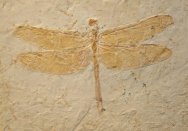Cordulagomphus tuberculatus Dragonfly
Class Insecta, Order Odonata, Family Proterogomphidae
Geological Time: Lower Cretaceous Late Aptian-Cenomanian (108-92 million years ago)
Size: Dragonfly fossil has 50 mm wingspan, Head-Body length 30 mm
Fossil Site: Crato Formation, Nova Olinda Member, Ceara, Brazil
 Description:
The Araripe Basin of Brazil is home to a fantastic array of exquisitely-detailed
Early Cretaceous fossils, some of which have been preserved in
three dimensions. While the entire formation has until the last
decade or so been termed the Santana Formation, David Martill has
separated out the slightly older insect-bearing strata as the Nova
Olinda Member of the Crato Formation. Quarrying
operations for the purposes of obtaining paving stones exposes
the remarkable
insect fauna in much the same way that quarrying for lithographic
limestone in Solnhofen has
afforded a panoply of wonderfully-preserved Jurassic fossils in
Germany. In addition to the many orders of
insects, spiders, scorpions, decapod crustaceans, and many plants
have been found. Interestingly, to date no pterosaurs or terrestrial
vertebrates have been found, in stark contrast to the overlying
Santana Formation deposits.
This specimen is a member of the Odonata (dragonflies and damselflies).
The Odonata are well-represented
in the fossil record, with some 700 species known. They have their
origin in the proto-Odonates from the Carboniferous. Meganeuropsis
from the Permian of North America, with a 75 cm wingspan, was the
largest insect on record.
Note the incredible detail, including the delicate venation of
the wings. Description:
The Araripe Basin of Brazil is home to a fantastic array of exquisitely-detailed
Early Cretaceous fossils, some of which have been preserved in
three dimensions. While the entire formation has until the last
decade or so been termed the Santana Formation, David Martill has
separated out the slightly older insect-bearing strata as the Nova
Olinda Member of the Crato Formation. Quarrying
operations for the purposes of obtaining paving stones exposes
the remarkable
insect fauna in much the same way that quarrying for lithographic
limestone in Solnhofen has
afforded a panoply of wonderfully-preserved Jurassic fossils in
Germany. In addition to the many orders of
insects, spiders, scorpions, decapod crustaceans, and many plants
have been found. Interestingly, to date no pterosaurs or terrestrial
vertebrates have been found, in stark contrast to the overlying
Santana Formation deposits.
This specimen is a member of the Odonata (dragonflies and damselflies).
The Odonata are well-represented
in the fossil record, with some 700 species known. They have their
origin in the proto-Odonates from the Carboniferous. Meganeuropsis
from the Permian of North America, with a 75 cm wingspan, was the
largest insect on record.
Note the incredible detail, including the delicate venation of
the wings. |



